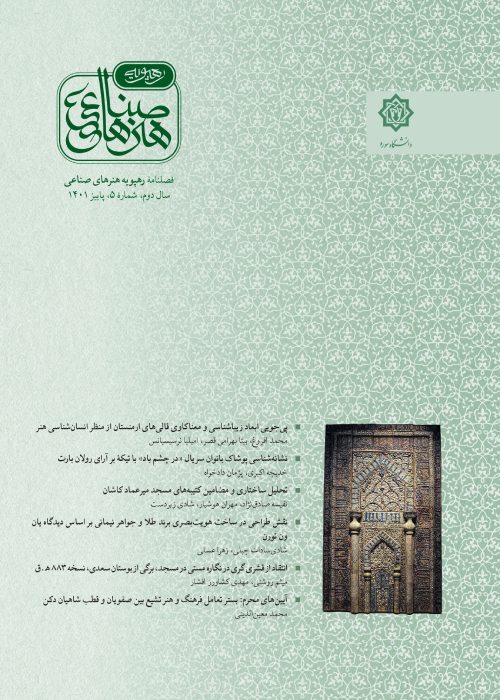Criticism of fundamentalism in miniature of A drunkard in the mosque, a page from Bustan Saadi, Version 883 AH.
Author(s):
Article Type:
Research/Original Article (بدون رتبه معتبر)
Abstract:
During the era of Sultan Hossein Baiqara and the ministry of Khwaja Nizamul-Molk Khafi, despite the prosperity of Herat City, the emergence of a kind of fundamentalism in the society was prominent and caused dissatisfaction. Considering the relationship between art and political and social necessities in this era, the painting of a story from Bostan Saadi, with the subject of a drunkard person and a muezzin, in the version of 883 AH, is a significant issue; In this miniature, the emergence of fundamentalism was mentioned and it seems to be related to the social situation of this era. Therefore, with the aim of cognition of the relationship between the occurrence of fundamentalism in the court of Sultan Hossein Baiqara and the depiction of the drunkard in the mosque, this question was raised: What is the relation of selecting the story of drunkenness in the mosque from Bustan Saadi, for miniature in the 883 AH, version of Bustan Saadi, with the revealing of fundamentalism in the court of Sultan Hossein Baiqara? The necessity and importance of this article also in examining the social-political aspects of Iranian art. In this study, the descriptive-analytical and historical research methods and the data collection methods are documentary and library. The results show that visualizing the miniature of drunkenness in the mosque, embodying the contemporary social situation in Herat, distaste for fundamentalism, and the need to pay attention to monotheism are warned. Also considering the emergence of fundamentalism during Saadi's lifetime, in the story of the drunkard in the mosque, the fundamentalism that emerged in the community has been criticized and admonished as a moral and social problem. In this miniature, on the one hand, by using the way of space creation and motifs common in the Timurid period, the story of Saadi is rearranged in the era of Sultan Hossein. On the other hand, the method to visualize and add elements such as the image of a surprised youth, the hands and face of a drunkard as a defenseless and astonished person, pride and arrogance in the behavior and face of the eunuch, as well as the contrasts formed between the forms, figures, and atmosphere of the mosque, distinguishing fundamentalism and monotheistic faith in this era is considered visually and semantically. In this regard, the way of choosing noble Quranic verses and their role in the double inscription in this image is such that the distinction between fundamentalism and monotheistic faith in relation to Saadi's story and the visual and semantic qualities of this image is doubly noticed and necessary and advises to avoid this behavior from the point of view of divine laws. Therefore, in this miniature, while rearranging Saadi's story and using Quranic sources, the fundamentalism developed in the era of Sultan Hossein has been embodied and it has been warned to avoid it by using various artistic advice.
Keywords:
Language:
Persian
Published:
Journal of Industrial Arts, Volume:2 Issue: 3, 2022
Pages:
67 to 78
magiran.com/p2672578
دانلود و مطالعه متن این مقاله با یکی از روشهای زیر امکان پذیر است:
اشتراک شخصی
با عضویت و پرداخت آنلاین حق اشتراک یکساله به مبلغ 1,390,000ريال میتوانید 70 عنوان مطلب دانلود کنید!
اشتراک سازمانی
به کتابخانه دانشگاه یا محل کار خود پیشنهاد کنید تا اشتراک سازمانی این پایگاه را برای دسترسی نامحدود همه کاربران به متن مطالب تهیه نمایند!
توجه!
- حق عضویت دریافتی صرف حمایت از نشریات عضو و نگهداری، تکمیل و توسعه مگیران میشود.
- پرداخت حق اشتراک و دانلود مقالات اجازه بازنشر آن در سایر رسانههای چاپی و دیجیتال را به کاربر نمیدهد.
In order to view content subscription is required
Personal subscription
Subscribe magiran.com for 70 € euros via PayPal and download 70 articles during a year.
Organization subscription
Please contact us to subscribe your university or library for unlimited access!



